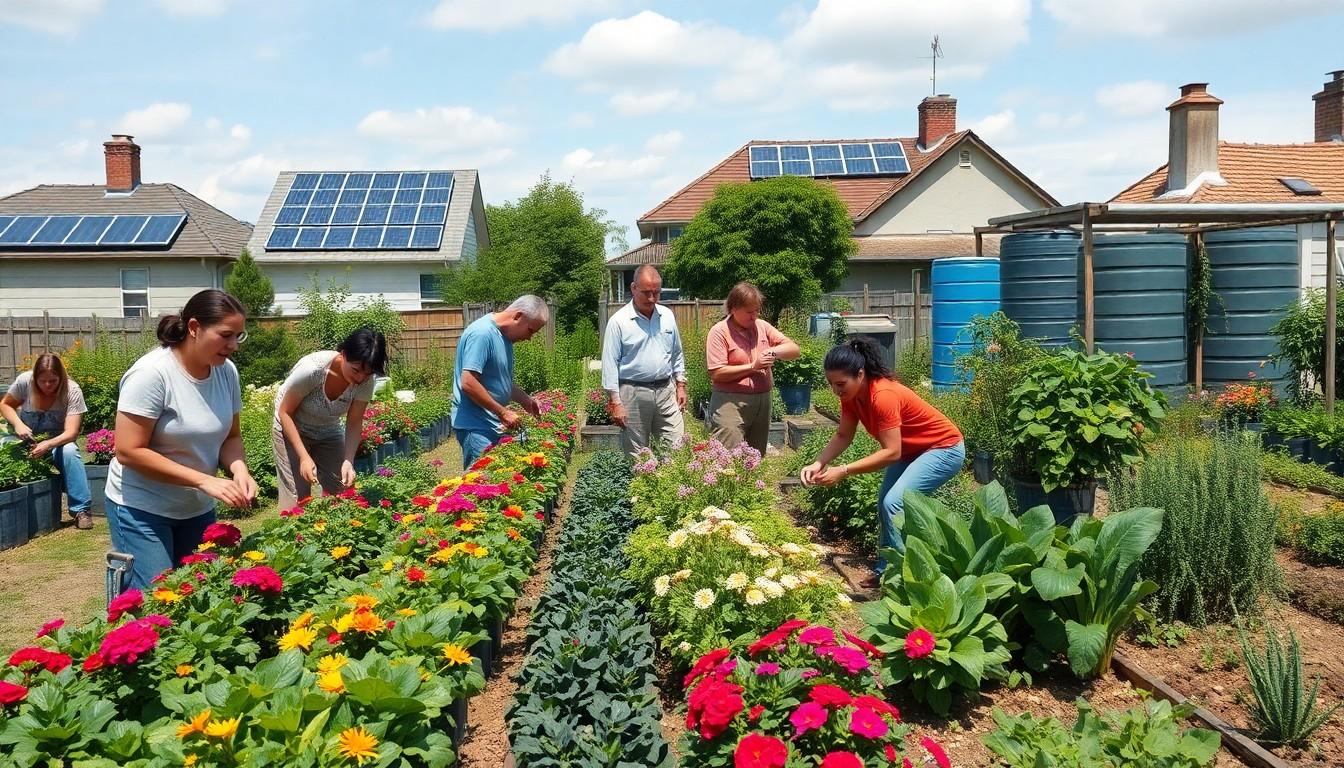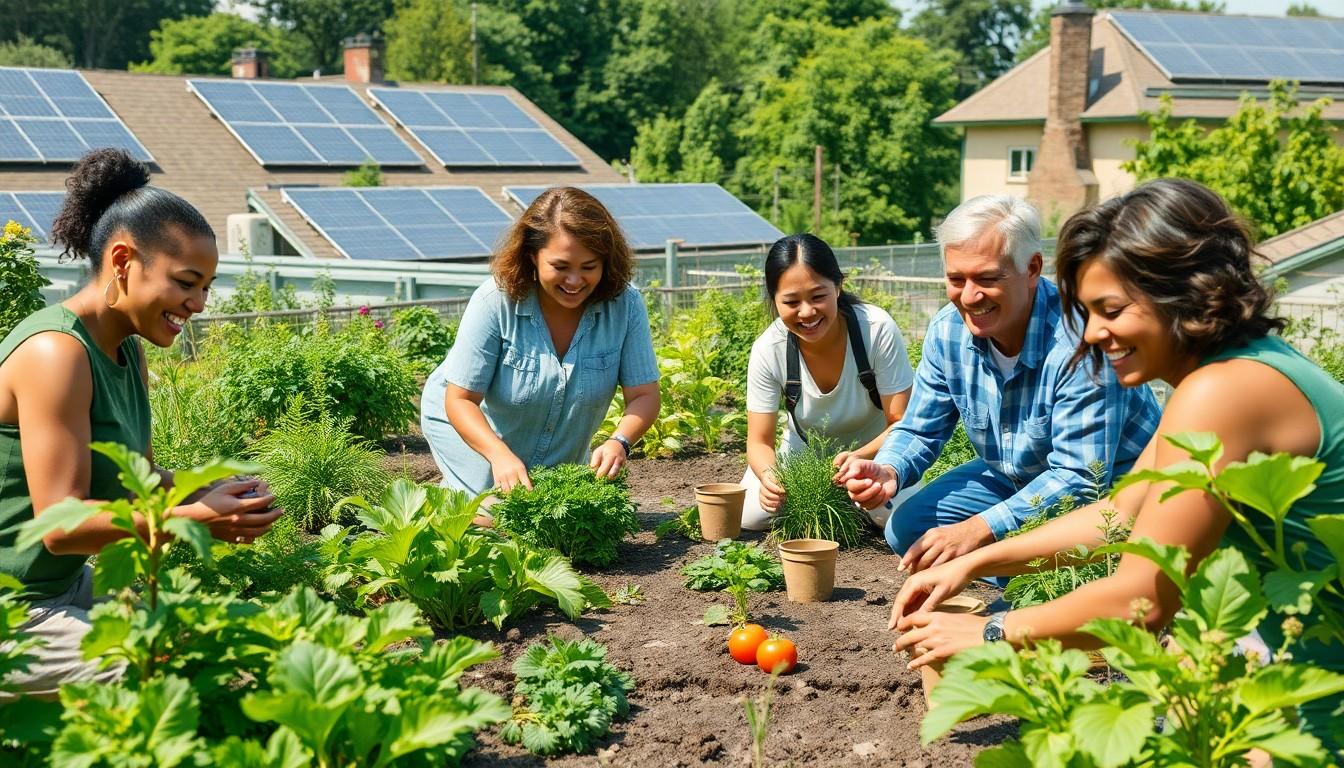Imagine a neighborhood where the grass is greener, the air is fresher, and your neighbors actually wave at you instead of staring at their phones. Welcome to the world of sustainable living communities, where eco-friendly practices meet good old-fashioned neighborly vibes. These communities aren’t just about saving the planet; they’re about creating a lifestyle that feels good—like wearing your favorite sweater on a chilly day.
Sustainable Living Community
Sustainable living communities prioritize eco-friendly practices while building strong relationships among residents. These neighborhoods often incorporate renewable energy sources, such as solar panels, to reduce carbon footprints. Community gardens represent another common feature, providing fresh produce and fostering social interactions.
Residents actively engage in shared responsibilities, promoting recycling, composting, and waste reduction. Shared spaces serve various purposes, including workshops on sustainable practices, enhancing knowledge among members. Decision-making processes generally involve open discussions, allowing everyone to contribute ideas and solutions.
Local economies benefit from sustainable living communities through the support of small, eco-conscious businesses. Farmers’ markets typically flourish in these areas, creating access to organic foods while encouraging sustainable agriculture. These practices not only support health but also nurture local ecosystems.
Educational programs underscore the importance of sustainability. Workshops often focus on topics like energy conservation, water management, and permaculture techniques. By sharing resources and knowledge, individuals feel empowered to lead more sustainable lifestyles.
Community initiatives frequently expand beyond environmental concerns. Social events strengthen relationships among neighbors, fostering a sense of belonging and purpose. Volunteer programs address local needs while creating connections, ensuring a cohesive community.
Sustainable living communities exemplify a holistic approach to environmental stewardship and personal well-being. Through collaboration and shared values, residents contribute to a healthier planet while enjoying a fulfilling lifestyle. This model encourages others to adopt similar practices, amplifying the impact of sustainable living on a broader scale.
Principles of Sustainable Living

Sustainable living communities thrive on principles that prioritize both the environment and social well-being. These principles guide residents in their efforts toward eco-friendliness and community engagement.
Environmental Considerations
Environmental factors play a crucial role in sustainable living. Communities implement renewable energy solutions like solar panels, reducing reliance on fossil fuels. Green spaces, including community gardens, not only provide fresh produce but also improve air quality. Rainwater harvesting systems capture valuable water resources, promoting efficient usage. Waste management practices like composting and recycling minimize landfill contributions. Each homeowner’s decisions collectively enhance the overall ecological health of the community.
Social Responsibility
Social responsibility nurtures strong bonds among residents. Engaging in community service fosters a sense of belonging and support. Local businesses thrive within sustainable living communities, reducing environmental footprints through shorter supply chains. Educational initiatives equip residents with knowledge on energy conservation and resource management. This empowerment leads to informed decisions that benefit the community as a whole. Shared events, such as workshops and potlucks, further cement relationships, creating an inclusive atmosphere for all.
Benefits of Joining a Sustainable Living Community
Joining a sustainable living community offers various benefits that enhance the overall experience of its residents.
Enhanced Quality of Life
Improved air and water quality significantly elevates daily living standards. Green spaces and community gardens provide access to fresh produce, which promotes healthier diets. Renewable energy sources like solar panels reduce utility costs while providing eco-friendly energy solutions. A close-knit community fosters relationships that enhance emotional well-being. Social events and workshops create opportunities for learning, further enriching residents’ lives. Together, these aspects create an environment that cultivates satisfaction and well-being.
Community Support and Engagement
Strong community ties generate a supportive network for individuals and families. Shared responsibilities help residents work together toward common goals, reinforcing their sense of belonging. Regular social gatherings encourage meaningful connections, making it easier to face challenges. Local businesses benefit from the support of engaged residents, contributing to a thriving economy. Educational initiatives provide residents with the knowledge needed for informed decision-making. Ultimately, active participation in community events builds bonds that enhance the collective quality of life.
Challenges Faced by Sustainable Living Communities
Sustainable living communities encounter various challenges that can impact their effectiveness and growth. Addressing these hurdles is crucial for their long-term success.
Economic Viability
Economic viability remains a pressing concern for sustainable living communities. Initial investments in renewable energy technologies, while beneficial in the long term, often require significant upfront capital. Small eco-conscious businesses within these communities may struggle to compete with larger, conventional companies, limiting their growth potential. Furthermore, maintaining competitive prices for organic food can be challenging. Residents may need to balance their commitment to sustainability with economic pressures, making it essential for communities to develop funding strategies and partnerships to support their initiatives. Effective financial planning promotes stability and attracts new members, strengthening the overall economic base.
Lifestyle Adjustments
Lifestyle adjustments represent another challenge for residents in sustainable living communities. Transitioning to eco-friendly practices requires commitment and adaptation. Many individuals face difficulties in changing long-standing habits related to consumption, waste management, and energy use. Participating in community workshops on sustainable practices supports residents in their adjustment journey. Encouraging participation in shared responsibilities fosters a sense of accountability and collective effort. For some, embracing a simpler lifestyle can feel restrictive, creating resistance to change. Continuous support and education play vital roles in helping residents make lasting changes that benefit both themselves and the community.
Eco-conscious and Connected Lifestyle
Sustainable living communities represent a powerful movement toward a more eco-conscious and connected lifestyle. By embracing shared values and responsibilities residents foster not just environmental health but also emotional well-being. These communities create environments where individuals can thrive together while making meaningful contributions to their surroundings.
As they navigate challenges and seek innovative solutions sustainable living communities continue to inspire others. Their commitment to sustainability and social engagement sets a precedent for future initiatives. Ultimately these communities demonstrate that a harmonious balance between personal fulfillment and ecological responsibility is not only possible but also immensely rewarding.

